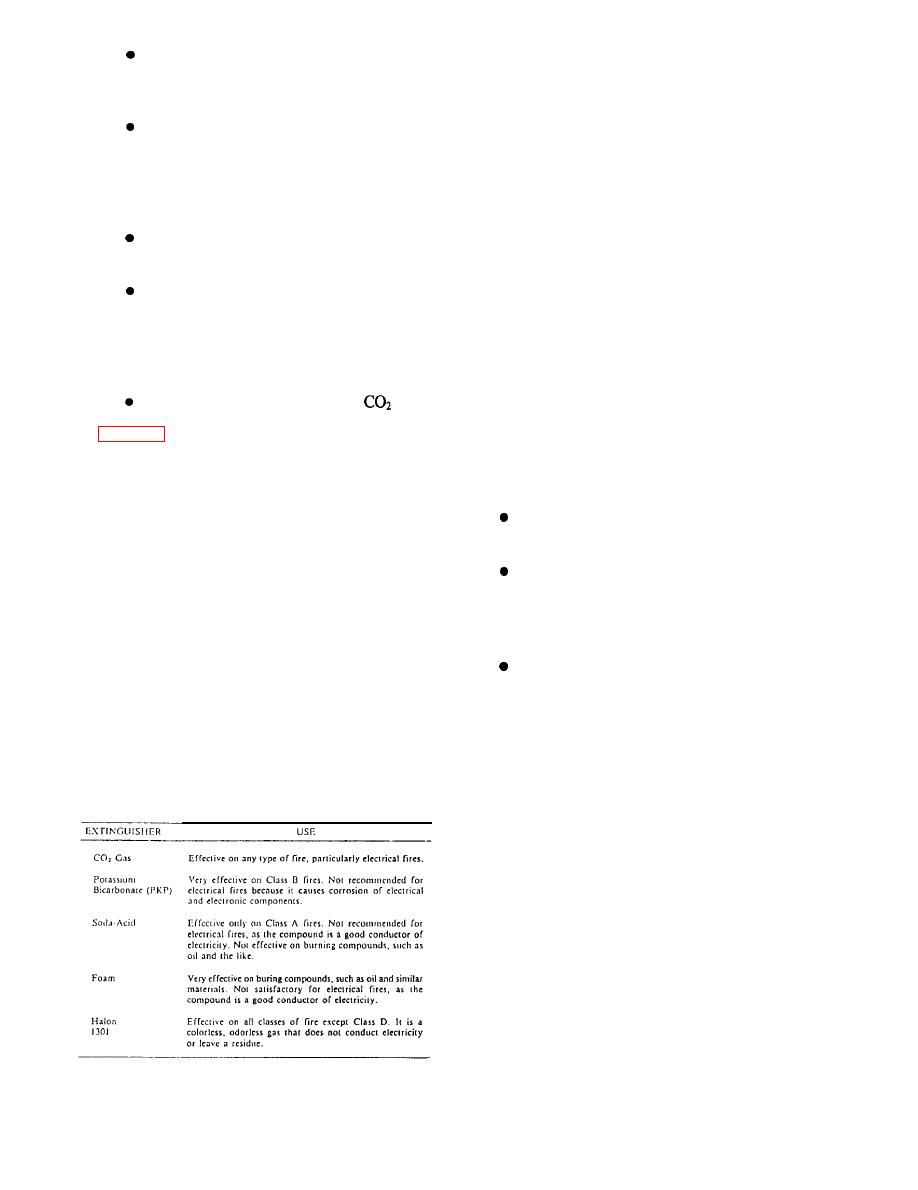 |
|||
|
Page Title:
Table 1-2.--Types of Fire Extinguishers |
|
||
| ||||||||||
|
|
 shut off, a potential may remain until an effective
Grasp the horn handle by the insulated
ground is established in some electronic equipment. It
(thermal) grip; the grip is insulated against
is emphasized that the nozzle should not be advanced
possible frostbite of the hand.
any nearer to the power source than 4 feet. Avoid
Squeeze the release lever (or turn the wheel)
prolonged exposure to high concentrations of carbon
to open the valve and release the carbon
dioxide in confined spaces since there is danger of
dioxide; at the same time, direct the discharge
suffocation unless an oxygen breathing apparatus
flow of the carbon dioxide toward the base of
(OBA) is used.
the fire.
ELECTRICAL SHOCK
Aim and move the horn of the extinguisher
slowly from side to side.
As an IC Electrician, you will be working in areas
Do not stop the discharge from the
and on equipment that pose serious shock hazards. If
extinguisher too soon. When the fire has been
you always follow the safety precautions outlined
extinguished, coat the critical surface areas
earlier, you can minimize the risk. However, you
involved with carbon dioxide "snow" to
should remember that the possibility of electrical
smother the fire by displacing oxygen,
shock is always present. If you are at the scene of a
mishap, you will be expected to help the victim as soon
Do not lose positive control of the
bottle.
as possible.
When 60-Hz ac is passed through a human body
that are normally available for use. Fire extinguishers
and the current is gradually increased from zero, it
of the proper type must be conveniently located near
could cause the following effects:
all equipment that is subject to fire danger, especially
high-voltage equipment. You should be extremely
1 milliampere (0.001 ampere)--shock is
careful when using fire-extinguishing agents around
perceptible.
electrical circuits. A stream of salt water or foam
directed against an energized circuit can conduct
10 milliamperes (0.01 ampere)--shock is of
current. When water is broken into small particles,
sufficient intensity to prevent the voluntary
(nozzle fog patterns), there is little or no danger of it
control of muscles. A person may not be able
carrying electric current under normal conditions of
to release the circuit.
fire fighting if the nozzlers are operated at least 4 feet
100 milliamperes (0.1 ampere)--shock is usu-
from the energized source. Nozzles and Navy
ally fatal if it is sustained for 1 second or more.
all-purpose (NAP) applicators, constitute a shock
hazard to the fire fighter due to accidental shifting to
The danger of shock from 450-volt ac ship's
a solid stream or by touching electrical equipment,
service systems is well recognized by operating
particularly with the applicator. Even after current is
personnel as shown by the relatively few reports of
serious shock received from this voltage. On the other
hand, a number of shipboard fatalities have occured
because of contact with 115-volt circuits. Despite a
widespread but totally unfounded popular belief,
low-voltage (115 volts and below) circuits are very
dangerous and can cause death. Shipboard conditions
contribute to the severity of shock because the body is
likely to be in contact with the ship's metal structure
and the body resistance may be low because of
perspiration or damp clothing.
Keep your clothing, hands, and feet dry if at all
possible. When you must work in a wet or damp
location, use a dry, wooden platform to sit or stand on,
and place a rubber mat or other nonconductive
material between you and the wood surface. When you
|
|
Privacy Statement - Press Release - Copyright Information. - Contact Us |